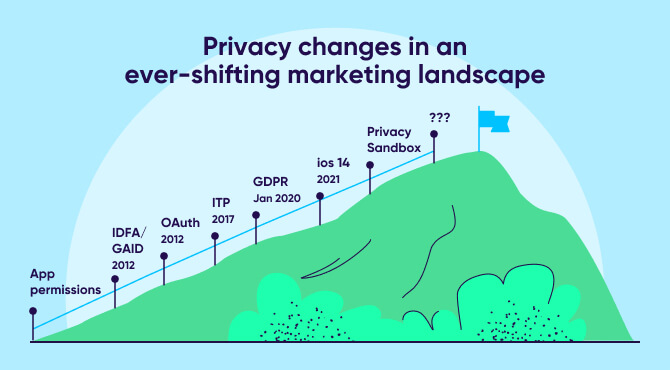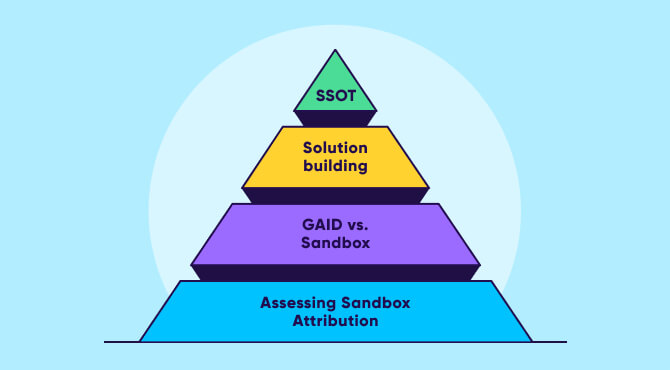
The roadmap to success on Android

How do you build a roadmap when so many external elements that will affect it are not yet released?
In essence, how can you unlock tomorrow, today?
Only a few weeks ago, AppsFlyer hosted “Introducing Privacy Sandbox”, an event for a select gathering of industry professionals to discuss the future of marketing and measurement. We were joined on stage by the Google Privacy Sandbox Product team, as well as our partners from Unity and Remerge, and the discussion was lively and thought-provoking.
To help you plan for success on Android and beyond, here are my reflections based on my industry knowledge as the designer of AppsFlyer’s SKAN solution and the product lead for AppsFlyer’s Privacy Sandbox solution.
One thing’s for sure – change is coming and adaptation is the only way forward.
A look back: Privacy changes in an ever-shifting landscape
GDPR, ATT, Sandbox. Most of us think of privacy in a prism, something that’s only recently developed and which is very isolated. However, privacy has consistently been a major part of the ecosystem.
Shifts and milestones have emerged throughout the years and yes, many have altered the ways in which we work, sometimes initially, causing panic. When ATT emerged on the scene many strategies had to be rethought or even cut altogether. However, once the dust settled, advertisers that adapted were able to thrive within the framework.
Now, let’s avert our gaze from looking back to looking forward. Google Privacy Sandbox marks the next wave of privacy-centric innovation, but it is by no means the last. We find ourselves in an ever-shifting landscape.
How do we prepare not just for Sandbox, but for future privacy shifts to come?
Let’s start by identifying the components most critical to privacy-forward technologies.

The principles of a good privacy solution
While thus far we’ve focused mainly on the perspective of the end-user, for privacy tech to truly move mountains, it needs to focus not only on the end-user but the advertiser as well.
The consumer perspective
If we’re looking at a good privacy solution, from the eyes of an end-user, there are two elements it should include:
- The privacy-related attributes:
- Data minimization – Take only what you need
- Transparency – Tell me why you need my data and what data points you’re using
- Consent/control – Ask my permission to use my data
- The personalization side:
- Consumer <> Brand relationship building – When end-users have a meaningful or emotional relationship with brands, they choose to return, time and time again
- Ads relevancy – The importance of showing relevant ads for the journey of an end-user cannot be emphasized enough. Seeing irrelevant ads disconnects you from companies and their products and could potentially generate higher ad overload in order to compensate for revenue loss. Not only irrelevant ads come as a result, but the immense quantities of irrelevant ads served too. YouTube, TikTok and others have all added additional ad units to counter existing ad formats that are underperforming, post ATT
- Contextual experience – The ability to retain a context even when moving from one app to another provides a much smoother experience for consumers
From the perspective of an advertiser
In the eyes of the advertiser for privacy solutions to be sustainable, they should include 3 main pillars:
- Targeting capabilities – Show relevant ads to the right people at the right time
- Measurement – Have the ability to attribute and determine if an ad led to the desired outcome
- Remarketing – Engage with your existing customers to retain them and drive growth (leading back to pillar number 2, measurement)
If we review both end-users’ expectations together with advertisers’ needs, we might think the two contradict.
They don’t.
Enter Android Measurement 2.0
Assuming GAID is going to be deprecated, I believe that the future of measurement on Android won’t be simple. It’s going to be good, but not simple.
I believe the future of Android measurement, much like iOS, will be built upon the OS solution (Sandbox) together with MMP attribution. If not done properly, there will be conflicting sources of truth. But before we jump into that and how it’s developed, let’s review the most important features Privacy Sandbox’s Attribution API has to offer.
If we go back to the pillars I mentioned earlier, we can see a direct connection between what the advertising ecosystem needs and what solutions are inherently provided, within the framework of Privacy Sandbox.
Targeting -> Topics
Measurement -> Attribution API
Remarketing -> Protected Audiences API
Measuring up: The Attribution API
The Attribution API is going to be a key part of our Android measurement solution, and as such will be the main focus of our discussion here (to read more about the other Privacy Sandbox solutions, click here.)
Here are the main features of the Attribution API:
- Different ad networks can be self attributed via the Attribution API. But only an MMP can determine cross-network last click attribution
- There’s a configurable lookback window, set by the advertisers (which can be controlled via the MMP in the same manner done today)
- Detailed campaign breakdown as well as detailed LTV breakdown
- Up to 30 days of post-install LTV measurement
- Web-to-app is supported
Putting everything to work, this is how we see the roadmap to Android Measurement 2.0:
- Assessing Attribution API. The first phase that AppsFlyer is currently focused on is testing the Attribution API. This requires testing with different partners and advertisers while making sure that the solution addresses advertisers’ needs. The Google Android team is extremely receptive and working with the wider industry. As a result of our work, several of AppsFlyer’s suggestions have already been updated in their product.
- Comparing current MMP attribution with the results of the Attribution API. Why is it vital that we start working on Sandbox right now even before a date has been set for GAID’s deprecation? Because now we can compare it to the GP referrer and GAID-based reality. To map gaps in the data and in the complete marketing picture. Leading me to the next step
- Building beyond the framework. After we identify the gaps, we are going to start building innovative solutions such as feature enhancements to the Attribution API, adding data science models to complete missing data, data enrichment with other sources, and more.
- Establishing the truth. The last and most important part is creating the source of truth – after having mapped the gaps, the different attribution methods, and building different solutions, our final goal and solution is to build the marketing picture that best represents the outcomes of marketing efforts.

Building your roadmap for Android success
Beyond what I’ve outlined above, I urge advertisers, marketers, dev teams, ad tech partners, and everyone throughout our ecosystem to take the following steps to embark on their journey toward success on Android.
- Verify your partners readiness across your techstack. Looking holistically through your techstack, there are many sources that are affected by changes in attribution and measurement. Beyond your MMP, your CRM, ad networks, and agencies all need to be preparing for this monumental launch. Additionally, any BI integrations should be testing GAID vs. the Attribution API, now.
- Lean into Sandbox with us. AppsFlyer has already begun to test Sandbox with advertisers. If you’re interested in being a part of those tests, please reach out to us. Additionally, we’re always here to discuss Privacy Sandbox (and measurement and privacy in general), and have many more regional events and webinars coming soon. Stay tuned!
- Start building solutions. AppsFlyer is here for you and will support you in this transition, but you know what best works for your business and if you build solutions on top of our offering, now’s the time to evaluate it for privacdy sandbox.
Moving forward
Our recent event with speakers from Google, Unity, Remerge, and Scopely was invigorating, but what I’m truly excited for happens now. We move forward, into the next milestone of privacy-centric measurement, to truly prove that privacy and business insights can go hand-in-hand. Or in other words, a win-win situation.




